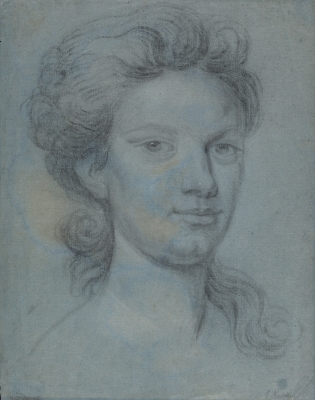This characteristic drawing provides insight into the workshop practice of London's leading portrait painter of the late seventeenth and early eighteenth centuries, Sir Godfrey Kneller. It was made by Kneller's studio manager, Edward Byng, to record the basic appearance of the work being produced. In 1879 the British Museum acquired from Byng's descendants six sketchbooks containing Byng's record drawings, and an album of drawings containing work by Byng, Kneller himself and other highly talented draughtsmen whose identities have not yet been established. Byng's collections comprise an extensive visual archive of the output of Kneller's portrait studio and of the Great Queen Street Academy.
The present sheet must have come from a further sketchbook or album: executed on the same paper it is numbered and marked with a small red chalk cross at the bottom edge, consistent with drawings in the British Museum. J Douglas Stewart, Kneller's most recent biographer, characterised his studio as: 'a somewhat loose congery of assistants, pupils, and, later, members of the Kneller academy' rather than a highly organised production line with assistants to prepare canvases and specialists contributing the drapery, hands, landscape and so on. It seems, though, that Kneller made great efforts to exploit the commercial opportunity that the demand for his works represented. At his death, Kneller’s studio contained four hundred unfinished canvases. Having an archive of small-scale drawings of portraits may have helped to impose a sense of order without which the studio machine may have ground to a halt. Byng’s distinctive drawings may well have provided a visual complement to financial records, or as an aid to clients and studio assistants when choosing a pose or having to make a copy in the absence of the prime version of the portrait. Whatever their precise purpose their number and survival warrants further research.


